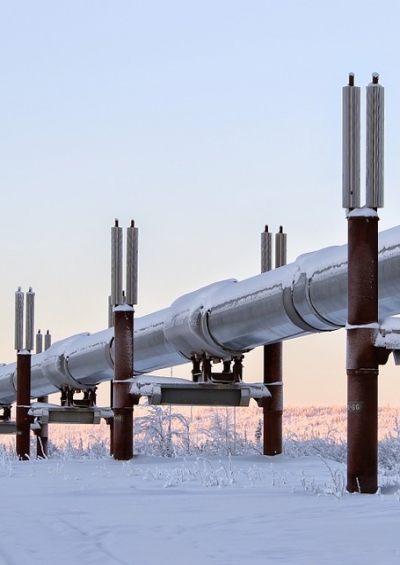Nord Stream 2: Falling at the Last Fence?
Thanks to interventions by Washington or Brussels, Nord Stream 2 may end up either not being completed or, once completed, find that much of the pipeline cannot in fact be used.
November 20, 2019

The Nord Stream 2 pipeline project has been subject to immense controversy ever since President Putin launched the project in tandem with his German business partners in June 2015.
Contrary to the desires of the German government, most of the Central and Eastern European EU member states have come out against the pipeline. The EU itself has formally extended EU energy law to import pipelines such as Nord Stream 2, while the Polish authorities have launched antitrust proceedings against the project.
Nevertheless, to date the project has continued to proceed. By late October 2019, approximately 80% of the pipeline route was completed. The Danish Energy Agency also finally granted a route permit, which will permit the final 300km of pipeline to be laid in Danish waters from early December 2019 onward.
Game set and match to Nord Stream 2?
North Stream boosters argue that, following the Danish approval, the pipeline cannot be stopped any longer. However, that conclusion would be premature.
There are two major problems facing Nord Stream 2. The first hails from across the Atlantic with the prospect of rapid imposition of U.S. sanctions. The second may very well hit the project from the EU’s nerve center in Brussels. There is a strong prospect that the European Commission will impose capacity restrictions substantially limiting the gas flows through the pipeline.
As much as the German government wants to avoid such an outcome, Nord Stream 2 may thus fall at the last fence. It may end up either not being completed or, once completed, find that much of the pipeline cannot in fact be used.
Don’t underestimate the Americans (united for once!)
The U.S. Congress has been moving to adopt targeted sanctions on Nord Stream 2. The bill sponsored by Senator Cruz is cleverly targeted on pipeline laying vessels which lay pipelines at over 100 feet.
Sanctions could be imposed on those who lease, sell or use the services of such companies offering such services and the companies themselves. There are few businesses offering deep water pipeline laying services and they all depend on work with U.S. or U.S.-connected energy firms.
It is not surprising therefore that Nord Stream 2’s current contractors have indicated that they would stop work the instant the U.S. authorities imposed sanctions. As the Cruz sanctions bill has already been approved in the relevant House and Senate committees a floor vote in both chambers could be called at any time, halting construction of the project.
Of course, there is always the possibility of a Trump veto, unimaginable as such a move would have been under any prior Republican president. But given that any such veto would anger Republicans such as one of the sanctions bill’s sponsors Senator Cruz, it is unlikely a President under threat of impeachment would want to upset any of the senatorial jurors who have the capacity to convict him.
U.S. sanctions legislation would bring the project to a juddering halt within a few hundred kilometers of its physical completion. It would thereafter be difficult for the project to be rapidly completed.
Ways to circumvent U.S. sanctions?
The CEO of Nord Stream 2, Matthias Warnig, discussed with Der Spiegel the option of welding the pipelines together on land and then deploying divers to put the pipeline sections in place.
This approach, clever as it sounds, raises a range of practical, safety and timing issues which will at least seriously delay the project. Nord Stream 2 can indeed seek its owner Gazprom’s help to upgrade existing Russian pipeline laying vessels, so that they can lay Nord Stream 2 pipes in the Baltic Sea. That may be the more practical solution, but it will also take considerable time.
Other competitors are entering the market
However, time is not something that Nord Stream 2 has. Other sources of supply are coming on stream that may very well begin locking Nord Stream 2 out of parts of the CEE market.
For instance, Poland has already given notice to Gazprom that it will terminate its Russian gas contract by the end of 2022. Warsaw by then will have in place a 10bcm Baltic Pipeline bringing Norwegian gas at much lower prices than Gazprom offers to Poland and other CEE states. By end of 2022, Poland will also have significantly expanded its LNG import capacity.
North Stream’s fate and the EU legal dimension
Market forces aside, on September 10th the EU General Court in the case T-883/16 Poland v. Commission laid down a substantial energy solidarity obligation on EU Member States and the European Commission.
The case involved the pipeline OPAL which is a connecting pipeline to Nord Stream 1. In essence, the EU Court imposed a broad obligation on any Member State regulator applying EU energy law.
It does not suffice if EU members just consider their own interests, because they have to consider the interests of all Member States as well as of the European Union as a whole.
Applying EU energy law, and in particular the Gas Directive 2009, to a pipeline such as OPAL or Nord Stream 2, requires a regulator to consider the impact that the pipeline would have on three factors – competition in the EU gas market, the security of supply and the functioning of the gas market.
If the German energy regulator, which is not autonomous, but overseen by the European Commission, has to consider the interests of all Member States and the Union as whole on the basis of the security and market criteria, then Nord Stream 2 will be in trouble.
Gazprom’s 2014/15 own goal
Given that Gazprom has sought already in 2014 and 2015 to reduce gas flows to some CEE states via Nord Stream 1 and OPAL, there is already a live supply security issue in play which would be exacerbated by Nord Stream 2.
Furthermore, one of the objectives of the Nord Stream 2 project was to terminate the existing Brotherhood pipeline route which runs through Ukraine once the new pipeline was up and running. However, as Brotherhood has more capacity than Nord Stream 2 and is not controlled by Gazprom and its allies, losing Brotherhood would reduce competition and increase Gazprom’s market dominance.
In such circumstances, the German regulator, with the support and supervision of the European Commission, may have no alternative but to impose capacity restrictions on Nord Stream 2.
As it stands, the OPAL pipeline is currently subject to a 50% capacity restriction to assist in maintaining competition and supply security in the market. There would be a compelling case for a similar capacity restriction in respect of Nord Stream 2.
The best case scenario for Nord Stream 2
The best case scenario for Nord Stream 2 may well be that, after all that expense, controversy and tribulation, the pipeline is ultimately built, after sanctions are imposed and with some delay.
However, in the process it will have spawned competitors, such as the Baltic Pipeline, and new LNG facilities in the region which generate yet more competition.
At the same time, its business prospects would be hurt because it will be subject to capacity restrictions . This would imply that the Brotherhood pipeline remains in use, and it can only ever use half of the Nord Stream 2 pipeline.
Conclusion: Yes, there is a rosy scenario
This would clearly be good news for the entire European Union: Nord Stream 2, contrary to the designs of its architects in Germany and Russia, may well become the trigger to increase route and supply diversity in the EU natural gas market.
In addition, it could force Gazprom to lower its prices and reduce its market dominance. That was probably not the plan President Putin was envisaging when he launched the project in 2015.
Editor’s note: In the interests of full disclosure, Dr. Riley has previously advised the Ukrainian energy company Naftogaz and the Polish energy company PGNIG.
Takeaways
The Nord Stream 2 pipeline has been controversial ever since it was launched. Nevertheless, the project has continued to proceed.
North Stream 2 boosters argue that following Danish approval the pipeline can no longer be stopped. That conclusion would be premature.
Time is not something that Nord Stream 2 has. Other sources of supply are coming on stream that may begin locking it out of parts of the CEE market.
It does not suffice if EU members just consider their own interests. They have to consider the interests of all Member States and the EU as a whole.
Contrary to the designs of its architects in Germany and Russia, Nord Stream 2 may become the trigger to increase route and supply diversity in the EU natural gas market.

